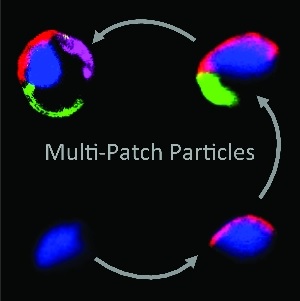A team of researchers from the U.S. and Germany has developed microparticles capable of carrying three different molecules on three different docks, or "patches." They could eventually provide a one-two-three punch against cancer, the researchers say.
 |
| Microparticles with multiple "patches" for holding molecules, noted by fluorescence--Courtesy of KIT |
With a technique that makes use of three different polymer solutions, the scientists manufactured the tiny microparticles with compartments, each of which can hold a different substance. In the case of drug delivery, these can be filled with three different molecules that could, for instance, perform separate tasks. Depending on which drugs are used, one could be used as a targeting mechanism, the second could blast open a cell membrane and the third could induce the cancer cell's death, according to a report from the university.
"Microparticles with structured surfaces that can be loaded selectively with various molecules have an enormous potential for medical applications," said Christoff Wöll, a professor at the German Karlsruhe Institute of Technology. Scientists from KIT and the University of Michigan contributed to the study, which was published online Feb. 14 by the journal Angewandte Chemie.
What gives these particles the ability to hold three different molecules are the three different polymers the scientists used to make them. Each polymer has its own chemical anchor group that doesn't influence the other. In their study, the team used fluorescent biomolecules to demonstrate that the particles would have three distinct patches capable of holding the molecules.
"Whereas spatially controlled development of chemical and biological ligands for two-dimensional substrates is well established, there are hardly any processes for the spatially controlled attachment to three-dimensional objects, such as microparticles," lead researcher Jörg Lahann said in a statement.
Next, the team will look into reducing the size of the microparticles to the nano scale, giving them more real-life capabilities.
- here's the KIT report
- get the research abstract